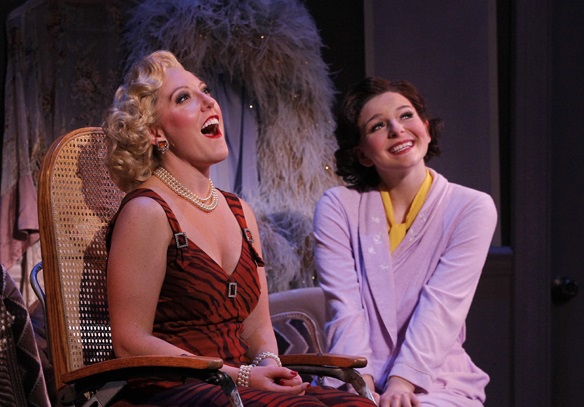Take your dancing feet down to “42nd Street” playing at the Segerstrom Center for the Arts, Nov. 10 – 22. “42nd Street” tapped its way into the hearts of 80’s audiences winning the 1981 Tony for “Best Musical” and “Best Choreography.” Until then precision tapping with big kaleidoscopic numbers hadn’t been popular since the depression era Warner Brothers films. Broadway’s “42nd Street” bought back Busby Berkely’s style of musical extravaganza.
Take your dancing feet down to “42nd Street” playing at the Segerstrom Center for the Arts, Nov. 10 – 22. “42nd Street” tapped its way into the hearts of 80’s audiences winning the 1981 Tony for “Best Musical” and “Best Choreography.” Until then precision tapping with big kaleidoscopic numbers hadn’t been popular since the depression era Warner Brothers films. Broadway’s “42nd Street” bought back Busby Berkely’s style of musical extravaganza. Then as grandiose shows with elaborate sets became popular Broadway staples, tapping once again took a back seat to splashy modern choreography. That tap is still one of the most entertaining and electrifying dance forms is proved by the success of the 2001 hit revival of “42ndStreet.” Now, the celebrated show is on tour and coming to the OC bigger and better than ever. In the words of Director and book co-author Mark Bramble “When we did the revival, I said, let’s do the MGM color version.” That’s exactly what audiences will get when “42nd Street” swings into the Segerstrom Center. In addition, to fanatic tap numbers, are some of the greatest classic songs ever written, such as “Lullaby of Broadway,” “Shuffle Off to Buffalo,” “I Only Have Eyes For You,” and it’s signature song “42nd Street.” “42nd Street” is the story of hopes and dreams of Broadway glory as it follows a young ingénue from chorus girl to star. It showcases the reality of working on Broadway. That and of course, the incredible tap numbers are what drew dancer Patrick Heffernan to audition for the ensemble in the touring production. Heffernan was just the type of dancer Randy Skinner, who co-choreographedthe 1980 show and revived the choreography in 2001, wanted. He says of the young, energetic cast of 38 “we have a whole new generation of dancers who can tap brilliantly, so I added more challenging steps.” Heffernan, who hails from Mission Viejo, began his affair with theater around the 6th grade. His first musicals were in family friendly community theater in Irvine, once bitten he never looked back. He moved to New York to attend Wagner University on Staten Island where he minored in dance and majored in theater performance. He says of the move across the county “It was a nice way to bridge the gap between New York and Orange County. New York is the center of the theater world and I don’t think I would have had as many opportunities to join that world without attending Wagner University. It’s all happening in Manhattan and that’s where I need to be.” “42nd Street” is renowned for flashy tap numbers. Heffernan considers his strong point to be musical theater dance, and says of “42nd Street” that he has always been attracted tolarge, glitzy shows featuring dance, especially tap because “tap is exciting, it stimulates more senses, visual, audio, sight then other dance forms.” He continues, “I’m attracted to musical theater because of the story telling and because of my training. I have skills in singing, dancing, and acting and this has benefitted me in the long run with more respect and more roles.” Director Mark Bramble labels “42nd Street” as a Cinderella story with a show biz twist. It’s the tale of a hopeful hoofer, Peggy, fresh from the boondocks who lands a job in a Broadway chorus, replaces the leading lady and becomes an overnight star. As Bramble says, “It’s a story that makes you feel good. People always want to see an affirmative, optimistic story.” For an ensemble player like Heffernan, it’s the story of his life. Being in the ensemble is where Heffernan says he relates best to the show because “that’s where I work. We, the cast, audition in real life, we audition in the story. We do our best to get the job, in the show & for real, because that’s what makes us happy. It’s a musical but it’s also our story.” There is no doubt that “42nd Street” with its big production numbers is a show that everyone knows. Heffernan says “the two creative geniuses’, Bramble and Skinner have brought the touring production to a fresh and exciting place with a talented youthful cast.” The Great Depression is the backdrop for “42nd Street,” something audiences often overlook because of dazzling dancing. Bramble wanted to give the show authenticity while allowing his actors room to grow into their parts. To this end he assigned each actor the task of finding someone who was alive during the Depression and listening to their stories. Heffernan says “We had no idea what happened in the 30’s so we had to contact someone from that era – for me it was my Grandmother who told me about her parents’ lives. Most of us are too young to have been aware of those times so hearing the stories from one another was a great bonding experience.” Despite “42nd Street being set in the Depression it ishopeful, optimistic, upbeat and fun. And what Heffernan likes best “is it’s about theater, it’s easy to relate to because it’s about us, the cast. In the 1930’s, they were dancing for their lives. Now it’s about our lives, just with less desperation. And in hard times, people go to the theater to laugh, to be entertained and to forget their woes. That never changes.” Heffernan recommends “42nd Street” to audiences, saying, “Theclassic musical is one of the best tapping shows ever.” He believes “42nd Street” continues to excite audiences because of the elaborate spectacle and joyful songs. “42nd Street” is playing at the Segerstrom Center for the Arts Nov.10 – 22 in Segerstrom Hall. For tickets and information in person: The Box Office (600 Town Center Drive, Costa Mesa, Ca. 92626); by phone: 714-556-2787: online: SCFTA.org. Hours are 10 a.m. – 6 p.m. daily.









